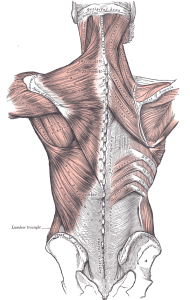The thoracolumbar fascia
When looking at anatomy pictures depicting the back of the body, there is a large white or grey patch between the pelvis and the ribcage that represents the thoracolumbar fascia.
Fascia is connective tissue that envelops the entire body.
The thoracolumbar fascia is also considered an aponeurosis, which is another type of connective tissue, essentially a flat sheet of tendon that helps to bind muscles and connect the muscles to our bones.
The thoracolumbar fascia is one of the more important parts of the body as it interacts with many muscles and ligaments and transfers load or energy from the ribcage to the pelvis.
The thoracolumbar fascia also plays an essential role in walking as it harnesses and facilitates many of the forces required for gait— especially contralateral, or alternating, movement.
To a certain degree every step we take is a spinal twist and this twist is expedited through the thoracolumbar fascia.
The thoracolumbar fascia is made up of three layers—Anterior (front), middle and posterior (back)—with the anterior being the thinnest layer and the posterior the thickest.
It relates to and has great influence on many of the muscles between the pelvis and ribcage while also influencing structures that reside above and below.
Both the anterior and middle layers attach to the transverse processes of the spinal column.
The quadratus lumborum lies between the anterior and middle and the erector spinae muscles are found between the middle and posterior layers.
The middle layer also gives rise to the transverse abdominis muscle.
The Posterior layer is involved with many different moving parts from the pelvis all the way up to the head through the erector spinae muscles and the nuchal fascia.
The posterior layer attaches to both the erector spinae and gluteus maximus aponeurosis.
In addition, the posterior layer of the thoracolumbar fascia attaches to the internal oblique, serratus posterior inferior, sacrotuberous ligament, posterior iliac spine of the pelvis as well as the sacral crest.
And simply to keep listing (there could probably be ten or so blog posts hatched from this post) the posterior layer connects the gluteus maximus and latissimus dorsi with each other and this connection is what facilitates the oppositional movements of the arms and legs, which makes walking and running possible.
In addition this acts to stabilize the lower lumbar spine and sacroiliac joints.
One final thing to note is how a dysfunctional thoracolumbar fascia messes with the body.
It can result in excessively tight lower back muscles that refuse to release along with an increased curvature of the lumbar spine.
The sacroiliac joint, which creates problems for so many people, can lock up and become immovable.
One of the ways you can know if the thoracolumbar fascia is part of your problem is when treatments such as chiropractic, rolfing or massage help temporarily but the pain returns quickly. This is often the case with assorted shoulder and hip pain.
Is there more you ask?
How about muscle tension headaches? Quadratus lumborum pain? The answer to both is yes.
It can affect breathing by limiting the effectiveness of the diaphragm and it can also cut down on the thoracic spine’s twisting capacity which impacts the ability to walk well due to an inability to achieve the aforementioned, all-important, contralateral movement.
And how do we fix such problems? Get good bodywork and learn to walk.
***

